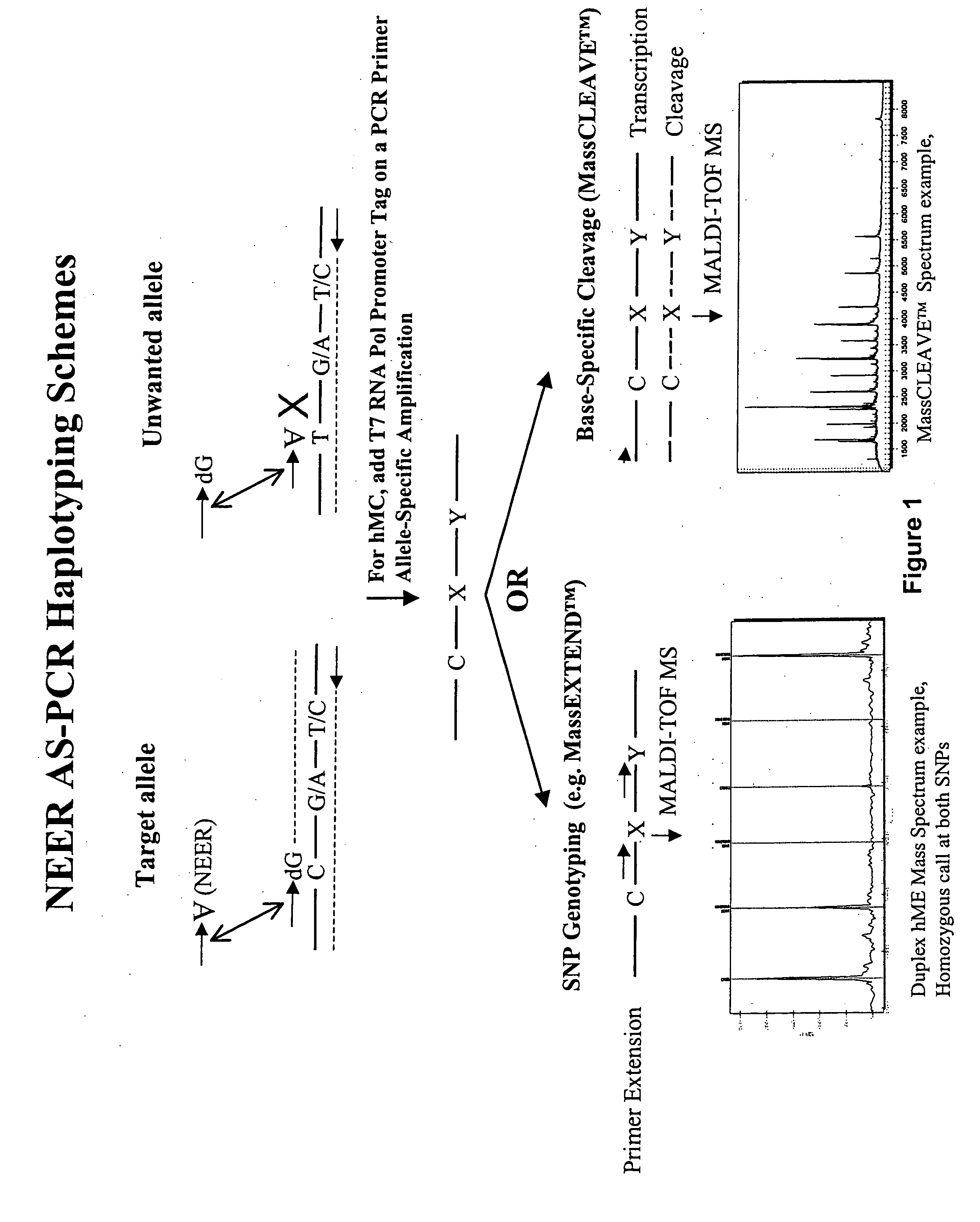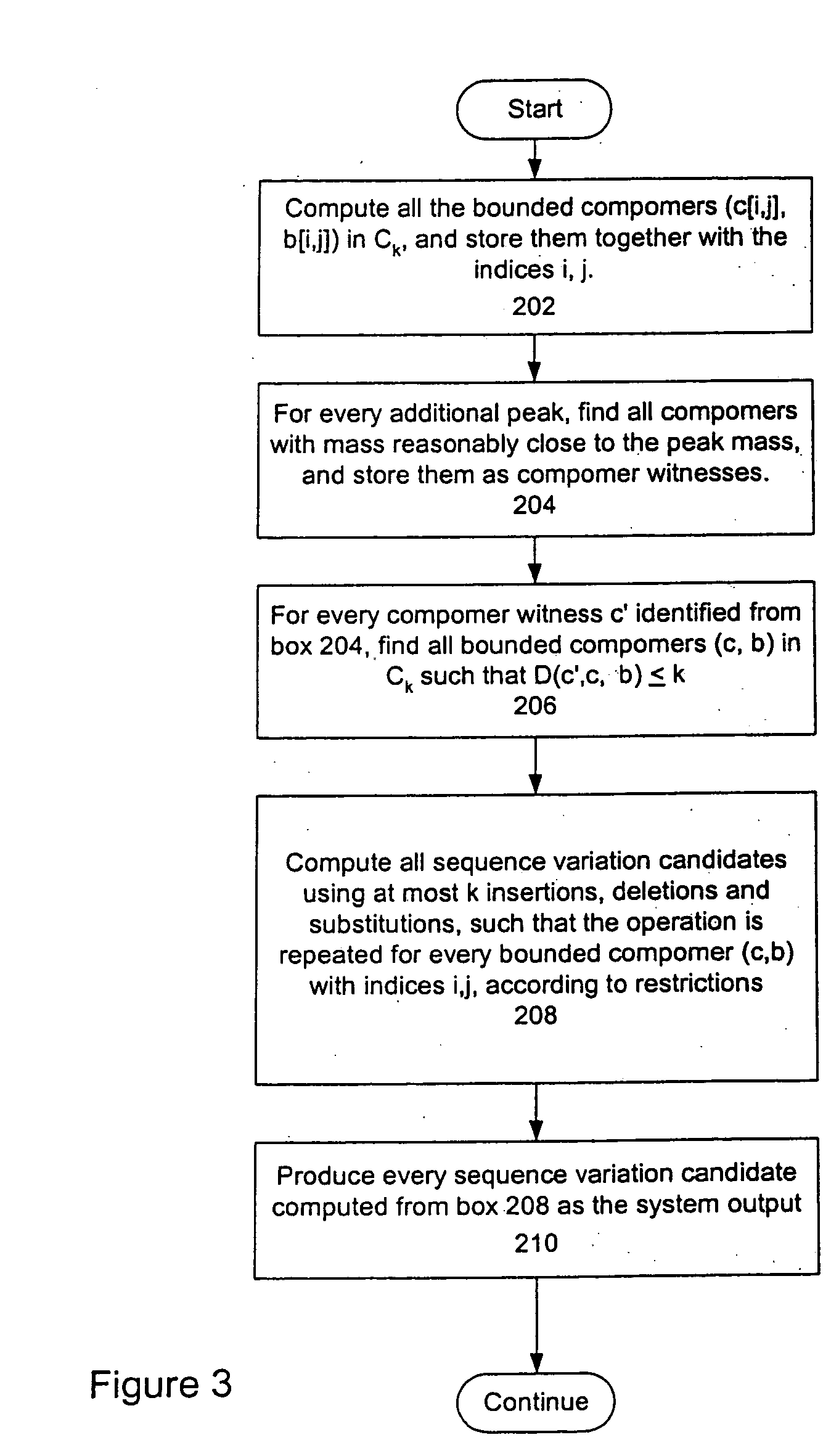Allele-specific sequence variation analysis
a sequence variation and allele technology, applied in the field of allele-specific sequence variation analysis, can solve the problems of high-throughput analysis of methods, and achieve the effect of reducing allele leakage and improving allele specificity
- Summary
- Abstract
- Description
- Claims
- Application Information
AI Technical Summary
Benefits of technology
Problems solved by technology
Method used
Image
Examples
example 1
Haplotyping Using NEER-ASPCR: Allele-Specific PCR with a Non-Extendable Exonuclease Resistant Competitor
[0432] The following haplotyping protocol describes the use of one embodiment of the allele-specific PCR amplification methods provided herein, referred to herein as Non-Extendable Exonuclease Resistant-Allele Specific PCR (NEER-AS-PCR). In these methods, the competitor oligonucleotide improves specificity of the AS-PCR amplification by reducing amplification of the non-desired allele (leakage), which can occur, for example, when the discriminatory end base involves a weak mismatch such as CA or GT. This Example demonstrates the usation of NEER competitors with 3′ inverted and dideoxy bases and also the use of mismatches in the penultimate base of the forward ASPCR amplification primer.
[0433] The AS-PCR reaction was conducted as follows. A sample of genomic DNA was isolated from 10 mL of buffy coat samples using the PUREGENE kit (Gentra Systems). The genomic DNA sample was purc...
example 2
NEER Competitor Concentration Titration
[0455] This example demonstrates the significant effects of NEER competitors in enhancing the specificity of AS-PCR.
[0456] A 220 bp amplicon from the IKBA gene locus (SEQ ID NO:2) was PCR amplified in the NEER-ASPCR reaction as described in Example 1 using the NEER oligonucleotide competitor 5′-GGCCAGCGTCTGACGTTATGAG ⊥-3′(SEQ ID NO: 4) in excess concentration to the AS-PCR forward and reverse primers ranging from 7.5 fold (1.5 mM) to 20 fold (4 mM). An hME primer mass extension was performed at an internal SNP, nucleotide 147 of SEQ ID NO:2 previously genotyped as heterozygous for the DNA sample amplified.
Primer Mass Extension Analysis of NEER-ASPCR Reactions
[0457] Genotyping of the NEER-allele-specific amplified targets can be carried out using any known method for genotyping, such as either base-specific fragmentation mass spectrometry analysis (e.g., MassCLEAVE™ assay) or primer extension (e.g., MassEXTEND™ reaction). In this example, ...
example 3
Haplotyping at a 2 Kilobase Locus
[0472] This Example demonstrates manipulation of the SNP Discovery Program to permit haplotyping.
[0473] A 1998 bp amplicon from the CEPT gene locus (SEQ ID NO:10) was PCR amplified in the NEER-ASPCR reaction as described in Example 1. The primers used for the NEER-AS-PCR reactions are shown in Table 6. The amplicon corresponds to the CEPT gene locus on chromosome 16 q13, position 5′-47292387-47290390-3′ on the minus strand.
TABLE 6SEQIDPrimer SequenceNO:AS-PCR5′-AAGAGCGGAGCTCTCCGAGTGA-3′11primer5′-CAGTAATACGACTCAGTATAGG-13GAGAAGGCTAAGAGCGGAGCTCTCCGAGTGA-3′5′-AAGAGCGGAGCTCTCCGAGTGC3′125′-CAGTAATAGGACTCACTATAGGGAGA14AGGCTAAGAGCGGAGCTCTCCGAGTGC-3′Competitor5′-AAGAGCGGAGCTCTCCGAGTG[invA]-3′15primers5′-AAGAGCGGAGCTCTCCGAGTG[3ddC]-3′163′ primers5′-CAGTAATACGACTCACTATAGGGAGAA-17GGGTAGCTGGAGATTTGAGGATGGCAGG-3′5′-AGCTGGAGATTTGAGGATGGCAGG-3′18
[0474] In the reactions a T7 promoter tag was present on either the 5′ or 3′ end primer. Primers SEQ ID NOS: 13, 14...
PUM
| Property | Measurement | Unit |
|---|---|---|
| mass | aaaaa | aaaaa |
| temperature | aaaaa | aaaaa |
| temperatures | aaaaa | aaaaa |
Abstract
Description
Claims
Application Information
 Login to View More
Login to View More - R&D
- Intellectual Property
- Life Sciences
- Materials
- Tech Scout
- Unparalleled Data Quality
- Higher Quality Content
- 60% Fewer Hallucinations
Browse by: Latest US Patents, China's latest patents, Technical Efficacy Thesaurus, Application Domain, Technology Topic, Popular Technical Reports.
© 2025 PatSnap. All rights reserved.Legal|Privacy policy|Modern Slavery Act Transparency Statement|Sitemap|About US| Contact US: help@patsnap.com



